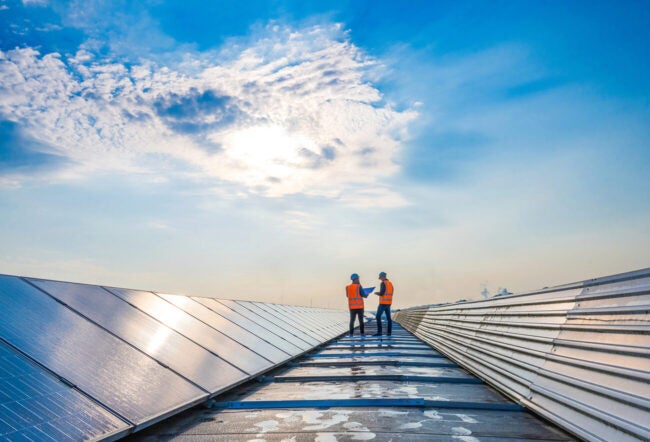 Water scarcity is a major environmental issue affecting many regions of the world. Journalist Judith Schwartz takes an in-depth look at the problem in her recently published book, Water in Plain Sight, which leads the reader on a global journey to learn about the root causes of water scarcity, and offers some solutions towards alleviate this perplexing problem. Schwartz recently visited with Knowledge at Wharton to talk about her book.
Water scarcity is a major environmental issue affecting many regions of the world. Journalist Judith Schwartz takes an in-depth look at the problem in her recently published book, Water in Plain Sight, which leads the reader on a global journey to learn about the root causes of water scarcity, and offers some solutions towards alleviate this perplexing problem. Schwartz recently visited with Knowledge at Wharton to talk about her book.
An edited transcript of the conversation follows:
Knowledge at Wharton: In your writing, you say that human beings are the greatest defenders of making this planet better and less thirsty. Can you explain?
Judith Schwartz: We have many challenges with water. It seems like every time you turn around, somewhere there’s a drought, there’s a flood, there are wildfires, which have to do with dehydration of landscapes. But it doesn’t have to be this way. A lot has to do with how we think about water, and I think that we can broaden out our water literacy. When we think about water as a kind of static resource — there’s this amount of water, and you get some and I get some — that kind of leaves us stuck. But once we understand how water moves across our landscapes and through the atmosphere, then we see that there are many opportunities to make better use of the water.
Knowledge at Wharton: You mentioned that in some parts of the world, water ends up being something that people fight over. It becomes a physical confrontation at times.
Schwartz: Yes. Again, I would reiterate that it doesn’t have to be this way. I talk to people, experts on water, about the prospect of water wars. What they said is that the lack of water often creates more opportunities for people to work together. But the important thing for us to recognize here, and I don’t think that we do this enough, is the connection between water and our landscapes. We’re continually focused on water that comes down from the sky. Our eyes are fixed to the rain gauge when we’re thinking about how much water we have and whether we get enough. But equally, if not more important, is what happens to that water when it hits the ground and whether we’re able to hold it in the landscape.
Once we understand how water moves across our landscapes and through the atmosphere, we see there are many opportunities to make better use of the water.
You mentioned water conflicts. It’s really important to know that most conflict areas around the world are in what we could call seasonal drylands. Understanding how to work better with those landscapes is really key. The unspoken word here that I think we could talk about more is “desertification,” which is basically the loss of land function. We can see that on the West Coast, too. The California drought goes in the news, goes out of the news continually these days. But what we don’t talk about is land degradation. That’s a really big part of what we’re dealing with in California.
Knowledge at Wharton: California has been the poster child of not using water properly over the last decade, maybe decade and a half. What are some of the things in California that are being missed and handled improperly?
Schwartz: One thing is cities. When we built cities, the way that we looked at water was as a nuisance. So, our built environments, our cities and suburbs are built so that water sluices away. We get rid of water as quickly as possible. But that’s problematic on many levels. For one, you’re losing that resource. Also, when you get rain in a city like Los Angeles, the water sluices away and carries pollutants along with it.
Finding ways to hold on to the water — there are many ways to do that. One is through water harvesting, and there are lots of different models. There’s a fellow who’s one of the experts in this. His name is Brad Lancaster. He has created a veritable oasis in Tucson, Arizona, and he has written about different approaches to water harvesting.
But another way to look at it, and this is what is very exciting to me, is to ask the question, “When these landscapes were functioning, what were the different factors?” We would never think of Los Angeles as a wetland area with deltas. But that’s how it was. In some areas, they are bringing back vegetation at the coast. Certainly, one project that’s going on now is the L.A. River, which is a concrete channel. What they’re doing is creating a linear park. In certain areas, it’s many miles long, so it’s a huge project. They’re adding vegetation and restoring the banks so that it’s beautiful, available for recreation and retains water.
Knowledge at Wharton: What really stirred your want to do a book about this topic?
Schwartz: Just before this, I wrote a book about soil. There were two things that kind of hit me and made me feel like I wasn’t able to let this material go. One was that land has been missing in our discussions about water. The other thing is that in a chapter I wrote called, “The Return of Lost Water,” I spoke with these interesting Eastern Europeans who have written a book called Water for the Recovery of the Climate, and the connection between water and the climate totally blew me away. When we hear about the connection, it always goes in one direction. It’s always that climate change will put added stress on water sources throughout the world, and of course this is true and very concerning. But what we don’t talk about is the effect that water has on climate. This also opens up tremendous opportunities once we start to understand this.
Knowledge at Wharton: You use the term water footprint, which is similar to the term carbon footprint, correct?
Schwartz: Yes, and I think that the water footprint concept is a really good educational tool to encourage people to think about the water that is being used for the food that they buy, the clothes that they buy and wear and the energy that they use, depending on your energy sources and your locality. I think it’s very useful, but it can be deceptive, and I’ll tell you why. One of the factoids in the water footprint library of data is that a hamburger uses some extraordinary number of gallons of water to produce. You look at that and think, “Oh my gosh, I’ve used this up.” But what is not included in that discussion is the way that the meat was sourced. So, you actually could eat meat that is restoring the planet, restoring soil and therefore holding more water. I make it a point to do this whenever I can.
Knowledge at Wharton: What’s the difference between the two?
Schwartz: In our industrial meat industry, water is wasted. You’re using water to grow the grain. You’re giving water to animals that are often being kept at the end of their lives in these feedlots, and these feedlots are creating methane. Because the animals are cramped, you need a lot of water to clean that out. It’s very energy intensive. It’s very wasteful on many levels, and that’s a problem.
When we built cities, the way that we looked at water was as a nuisance.
However, there is something called restorative grazing, holistic planned grazing in which livestock are managed in a way that they are restoring the land and building soil. Soil is really important. I’ll get back to soil. But they’re building soil, they’re grazing on natural pasture. Their actions on the land help improve the land. And by improving the land, the land holds much more water. I’ve visited places where rivers are coming back. I have eaten meat in Mexico, where they are managing land so as to restore the water cycle, but also to restore habitat for endangered migratory grassland birds. You can improve the landscape by managing animals in a particular way.
Knowledge at Wharton: Does part of this fall on farmers and ranchers to have this understanding and implement these types of beliefs and policies to regenerate the land and build the water supplies back up?
Schwartz: Yes. Many ranchers are motivated to do so for economic reasons because they do much better when the land is healthier. In the ranching community, this is happening more and more. In the farming community, they will do better when they are working more effectively with the water cycle. There are a lot of nuances in that area, too, in that a lot of the agricultural inputs actually undermine the biological system that allows plants to take up water effectively. There’s a whole other layer there. But the challenge in farming is that there are a lot of financial incentives, and the farm bills are so convoluted that some farmers are rewarded for practices that aren’t helpful to anybody. That’s where it gets complicated.
Knowledge at Wharton: It shouldn’t be hard for farmers to separate the two. Unfortunately, with the way that finance plays itself out in the farming sector, they are led to make one choice over the other.
Schwartz: That is true, and then you get kind of caught into a system. So many farmers say, “Gee, it isn’t working. The person says that if we add this input, it will be better.” It’s hard to break free of that. Also, there’s the matter of scale. There’s been an incentive for farms to get so large, and then they’re not as connected to the land. But I have worked with many farmers who are making it a priority to restore the land because they do see that is their bank, essentially. Healthy soil is their wealth.
We would never think of Los Angeles as a wetland area with deltas. But that’s how it was. In some areas, they are bringing back vegetation.
Knowledge at Wharton: You mentioned going to Mexico and seeing policies that help with the level of water in that country. Is this going on in other countries? Is the United States behind on this process?
Schwartz: I wouldn’t say that we’re behind. I would say that a lot of interest in this is bubbling up all over the world. I did go to Africa. I went to Zimbabwe, and that’s where Allan Savory, who is the fellow that developed holistic planned grazing, has the Africa Center for Holistic Management. That is where I saw tremendous, tremendous change and improvement. I had the opportunity to go visit some rural villages that the Africa Center for Holistic Management was working with, and these people were saying that they have been able to get off food aid because they had more command over the water. They had more access to water. And that was from the animal impact.
Knowledge at Wharton: That ends up being a rather significant economic impact on those countries, correct?
Schwartz: Yes, when the scale is large enough. I think to even try to make sense of the Zimbabwean economy would probably not be an effective exercise. But yes, certainly.
Knowledge at Wharton: California has been a focus of water usage and water supply in this country. But this is something that is playing out in a lot of other states, correct?
Schwartz: Oh, absolutely. You asked if we are behind in the U.S. I will say that one opportunity that has been missed so far is that there is an international initiative — I was at COP21 in Paris, the United Nations Climate Change Conference — and a growing movement around regenerative agriculture. Basically, it kind of lifts all boats. It helps everybody, and it helps restore ecosystems and all those co-benefits.
There’s an initiative called the “4 Per 1,000,” which has been launched by the French agricultural ministry. That’s a commitment to build carbon in the soil 0.04% every year. After five years, that basically offsets carbon emissions. I don’t have the figures in front of me, but that’s the idea. That has been signed by many countries. It has been signed by Mexico and Canada, but it has not been signed by the U.S. It really shifts the incentives for farmers and ranchers, for people who work the land. I think that’s something that we might want to explore a little bit more.
Knowledge at Wharton: You mentioned the term biodiversity. Go further into what that is and how that plays into this process.
When you give nature a little bit of a boost, it responds beautifully.
Schwartz: Biodiversity is the scope of the species and the richness of the wildlife and plant life in a particular area. It certainly makes sense that a healthy water cycle will support a greater number and variety of species. However, what I also found was that having greater biodiversity helped to support the water cycle. For an example, you mentioned California. We might ask what kept the water cycle functioning before we came in and we chopped down trees and plowed up land and built cities.
One answer was beavers. California had beavers throughout much of the state. Beavers are a keystone species. They’re known as nature’s engineers. They build dams, and those dams hold water. As water filters through, it creates very rich soil and wetlands, which hold water in the landscape. The driest state in our country is Nevada. There are projects in Nevada going on right now of inviting beavers back onto the landscape. They started with ranchers, restoring the soil, and then the beavers came. Now, they have much more water. They have rivers and streams that are now flowing year round. You get snow that falls from the Sierras, and then it gets held in the soil or it flows away.
Knowledge at Wharton: The same thing could very well happen in California because you’re talking about the same type of demographic where you have snow in the high elevations that’s coming down to the lower areas.
Schwartz: Absolutely. In California, there is now an organization called Occidental Arts and Ecology Center, and their WATER Institute has a “Bring Back the Beaver” campaign. There are many beaver fans out there. There are also fans of prairie dogs and dung beetles and other species that are actually very pivotal to the functioning water cycle.
Knowledge at Wharton: This is a process that is going to take time. But it’s one that has to be discussed, and probably at some rather high levels, in order to make some of these changes happen, correct?
Schwartz: That would be great. However, change often happens literally from the ground up. And these changes can happen very, very quickly. The ranchers that I visited in Mexico who are working with bird conservation organizations — that’s a partnership that you wouldn’t expect to happen. But one fellow, his name is Alejandro Carrillo — because the Chihuahua area of Mexico does get a decent amount of rain, he was able to transform his ranch within a couple of years. Because once you get the grass growing, then the birds show up. Nature wants to be complex. When you give nature a little bit of a boost, it responds beautifully.



